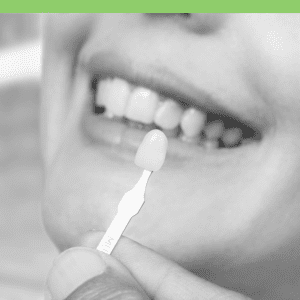 Qualified and experienced cosmetic dentists can create a stunningly natural look with veneers. They can be used for an impressive number of cosmetic corrections, ranging from teeth whitening to orthodontic adjustments. They are a great choice for masking discolorations, to brighten teeth, and to improve a smile, and can be the ideal choice for improving the appearance of the front teeth. Veneers are very thin shells made to fit over the front surface of a tooth, like a false fingernail fits over a natural nail. They are often made of porcelain (a medical-grade ceramic), but sometimes dental bonding, with a natural-color ‘composite’ resin material, is used.
Qualified and experienced cosmetic dentists can create a stunningly natural look with veneers. They can be used for an impressive number of cosmetic corrections, ranging from teeth whitening to orthodontic adjustments. They are a great choice for masking discolorations, to brighten teeth, and to improve a smile, and can be the ideal choice for improving the appearance of the front teeth. Veneers are very thin shells made to fit over the front surface of a tooth, like a false fingernail fits over a natural nail. They are often made of porcelain (a medical-grade ceramic), but sometimes dental bonding, with a natural-color ‘composite’ resin material, is used.
- They offer a conservative approach to changing a tooth’s color and shape.
- They can correct chips, cracks, gaps between teeth, and minor misalignment.
- They provide a natural tooth appearance.
- Gum tissue tolerates porcelain well.
- Porcelain veneers are stain resistant.
- The color of a porcelain veneer can be selected to make dark teeth appear whiter.
- They offer a stronger, more aesthetic alternative to crowns.
- They usually don’t require extensive shaping prior to the procedure that crowns do.
- They can be an intermediate option between bonding and crowns.
Bonding is a painless way to make minor repairs to teeth. Composite resin is put on the tooth and shaped, and then hardened with light. Composite veneers can be done in one visit. The advantages are that they can be:
- Color and contour matched to your teeth.
- Shaped to look like the missing part of a chipped tooth.
- Used to build up teeth and fill between them.
- Used on a broken tooth to restore it to size.
- Painted over a stained tooth to make it match the color of your other teeth.
- Applied in one visit.
Your dentist may be using advanced no-prep CEREC® (Chairside Economical Restoration of Esthetic Ceramics) technology with in-office fabrication to create the veneers, but if not, patients should also ask about the dental lab, because ultimately, the cosmetic results will depend on top-quality fabrication as well as the dentist’s skill. Some other types of veneers are Lumineers (a specific brand of very thin porcelain), and Zirconia veneers (a stronger porcelain, ideal when teeth are more severely damaged). If you want to know if veneers are right for you, you need to schedule an appointment with a skilled cosmetic dentist to evaluate your health history, current dental health, and the condition of your enamel, and then an informed decision can be made. If you do not qualify, these are some of the reasons alternative treatments can be suggested:
- If decay is found in a tooth or there is evidence of periodontal (gum) disease or root canal infection (these must be treated first).
- If a tooth has little enamel left, a veneer will not stick to it properly.
- If too much of the tooth is missing, a crown may be needed.
- If you grind or clench your teeth (called bruxism), porcelain veneers can chip or break.
The prep for veneers involves first removing a very thin layer of enamel from the front of the teeth to be treated. While the exact amount of enamel to be removed depends on the patient’s individual needs and the type of veneers being placed, in most cases, only about .5 – .7 mm of enamel on the front of the teeth must be removed. The amount may be so small that no anesthetic is required. The second step is to take impressions of the teeth. But if a dentist uses CEREC® technology, instead of impressions, a detailed sequence of pictures will be taken, which feeds into a chairside computer. Dental software then generates a three-dimensional picture of a patient’s mouth, and an in-office milling system fabricates veneers using these highly precise images. If a dentist works with an off-site lab, you will need to return for veneer placement, and a set of temporary veneers may be provided to protect the underlying dentin and prevent sensitivity. Immediately before placing veneers, an acid gel is applied to the teeth to dissolve some of the minerals on the surface of the teeth and create a rough surface on the microscopic level. Then the bonding agent is applied that adheres inside the tiny fissures on the tooth’s surface. This process creates a strong base for the porcelain veneers. Finally, dental cement is spread on the back of the veneers that affixes the porcelain on the front of the teeth. The color of cement is specifically chosen to coordinate with the veneers and match the natural color of a patient’s own teeth. A gentle force is applied to set the porcelain in place, and a curing light to stimulate a chemical reaction in the bonding agent hardens the cement in a matter of minutes. Depending on one’s need, just one or two veneers can be placed, but you can also combine veneers with other cosmetic treatments as part of a more comprehensive smile makeover plan. If you are interested in dental veneers in Costa Rica, fill out the “Find a Dentist” form on this page. One of our patient advocates will reply to your needs.





